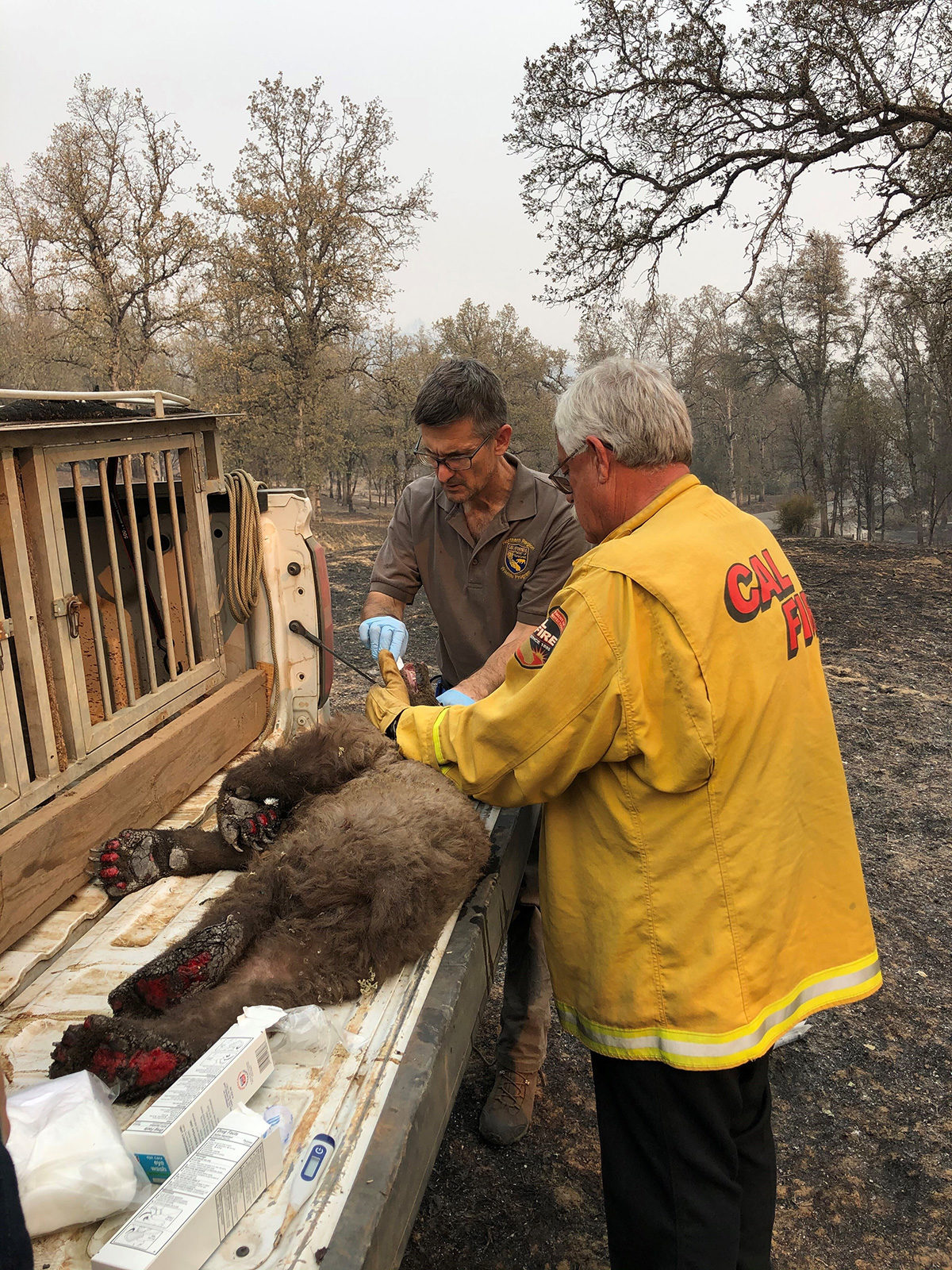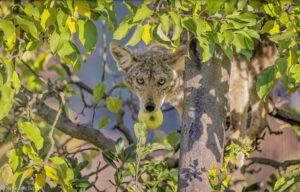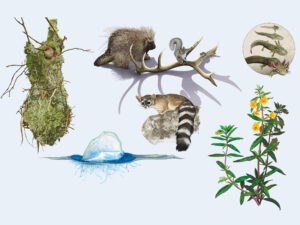
When the bear cub arrived at Gold Country Wildlife Rescue in Auburn, her paws were vivid red, the hair and skin on her face singed, and her eyes invisible under swelling. A team went to work immediately, sedating the bear and connecting her to fluids and antibiotics. Jamie Peyton, chief of Integrative Medicine at the UC Davis Veterinary Medical Teaching Hospital, set about soothing her pain, applying a topical cream and then suturing tilapia fish skins onto her paws and face to jump-start the healing process.
Days before, a detective with the Shasta County Sheriff’s Office had spotted the cub in a smoldering forest clearing near the town of Igo, as the Zogg Fire, which burned more than 50,000 acres south of Redding and killed four people in fall 2020, raged all around. The officer notified the California Department of Fish and Wildlife, which dispatched two of its biologists. They tracked her to a ranch, where they were able to tranquilize her using a blow dart in her perch at the top of a charred blue oak, flames still licking the base of nearby trees.
“She was the animal that had the most extensive burns on her face that I have worked with,” says Deana Clifford, a wildlife veterinarian with CDFW. Clifford consulted with Peyton to assess whether euthanasia might be the best option. But apart from the damage around her eyes, the cub appeared to be in relatively good shape, and her paws weren’t burned beyond the point of recovery. Peyton’s verdict: “Let’s give her a chance.”
Whereas systems are in place to rescue domesticated animals in the path of fire, until now wild animals have been largely left to their own devices. That’s where the Wildlife Disaster Network, a concept created by Peyton, comes in, linking animal rescue and treatment organizations, state veterinarians, and biologists and first responders. “In the past, we’ve often thought that wild animals just get out of the way of fires,” Peyton says. “But the problem now is that with the change in fire, in acreage and severity, these animals cannot get out.”
Started in 2020, the WDN provides a hotline for firefighters, utilities employees, or anyone else who spots a wild animal in distress. An associated team then goes out to rescue the animal and, if need be, coordinates treatment. Last year, organizations like the Oakland Zoo, Napa Wildlife Rescue, and Sonoma County Wildlife Rescue all treated wildlife saved from fires. But Gold Country took in the most animals for treatment because of its capacity and its proximity to both wildfires and UC Davis’ veterinary team. Through WDN, some 16 animals, including another cub, a mountain lion kitten, a bobcat, and several foxes and coyotes, were rescued last fire season. Five others were injured beyond recovery and were euthanized.
The goal is for every animal to return to the wild quickly. That has been possible in part through the pioneering tilapia-skin treatment Peyton used on the cub at Gold Country. Unlike more docile domestic animals, large wildlife are apt to tear away at their bandages. They also need to be released quickly before becoming accustomed to humans. The tilapia skin, sterilized to remove its fishy smell—and therefore make it less appealing as a snack to wild patients, though it won’t hurt them if they eat it—imparts collagen, which quickens healing.
“I started looking into something that would be a by-product that could be edible, that could help wounds heal faster and help with pain,” Peyton says. Now, she has worked with animal rescue centers and veterinary hospitals like the Oakland Zoo’s to teach their staff this technique.
The treatment and rescue itself are just one part of addressing the impacts of fire on wildlife. As part of the WDN initiative, Peyton also plans to conduct research into the toll the blazes are taking on animal populations and habitat. In the meantime, animal rescue organizations, the CDFW, and Peyton’s team are bracing for another megafire season, raising difficult questions about what responsibility people should take for the animals living nearby. That includes the possibility of euthanization, says Gold Country Wildlife Rescue president Sallysue Stein.
“We owe it to the animals that are being impacted by humans to try to help them.”
“I know animals die in the big scheme of things, and things happen to them out there in the wild that we know nothing about,” she says. “But we owe it to the animals that are being impacted by humans to try to help them.”At Gold Country last fall, the cub rapidly improved after treatment, nearly doubling in weight. A good sign came when she was no longer docile and lashed out at human caretakers. The swelling around the cub’s eyes went down, her facial scars healed, and she was able to walk on her four paws again. After a month, she was moved to Tahoe Wildlife Rescue, which specializes in bears. Too young to be released on her own, like all of us she spent the fall and winter sheltered in place. But this spring, finally safe to emerge, she was released back out into the wilds of Shasta County.
Previously this story reported that the cub was moved to the Tahoe Wildlife Rescue after two weeks. It’s been corrected to state the move came after a month.




